Fusion protein comprising an E. coli chaperone protein and a human chaperone protein
a technology of fusion protein and chaperone protein, which is applied in the field of cloning and expression, can solve the problems of accelerating the rate limiting steps of protein folding, affecting the activity of fusion protein, and affecting the activity of fusion protein, and achieves superior folding helper activity
- Summary
- Abstract
- Description
- Claims
- Application Information
AI Technical Summary
Benefits of technology
Problems solved by technology
Method used
Image
Examples
example 1
Production of a Chimeric Fusion Protein hFKBP12-IF1 Containing E. coli SlyD and Human FKBP12 Sequences
Cloning of Expression Cassettes
[0153]The sequences of hFKBP12 and SlyD were retrieved from the SwissProt database. Synthetic genes encoding hFKBP12 and its insertion variants were purchased from Medigenomix (Martinsried, Germany) and cloned into pET24 expression vectors (Novagen, Madison, Wis., USA). The codon usage was optimized for expression in E. coli host cells. The gene for SlyD was amplified by PCR from E. coli strain BL21 (DE3), restricted and ligated into the pET24a expression vector. The expression cassettes for the fusion proteins were designed as described for the E. coli SlyD* fusion module as described by Scholz et al. (2005) in J. Mol. Biol. 345, 1229-1241.
[0154]A synthetic gene (residues 1-155 of SEQ ID NO: 10) encoding the protein FKBP12-IF1 (also shown in SEQ ID NO: 10 with hexa-histidine tag (SEQ ID NO: 24))
[0155]
MGVQVETISP GDGRTFPKRG QTCVVHYTGM LEDGKKFDSSRDRNKPFK...
example 2
Spectroscopic Measurements
[0164]Protein concentration measurements were performed with an Uvikon XL double-beam spectrophotometer. The molar extinction coefficients (λ280) were determined by using the procedure described by Pace (1995), Protein Sci. A, 2411-2423.
[0165]Near-UV CD spectra were recorded with a Jasco-720 spectropolarimeter with a thermostatted cell holder and convened to mean residue ellipticity. The buffer was 50 mM sodium phosphate pH 7.5, 100 mM NaCl, 1 mM EDTA. The path length was 0.5 cm or 1.0 cm, the protein concentration was 20-500 μM. The band width was 1 nm, the scanning speed was 20 nm / min at a resolution of 0.5 nm and the response was 2 s. In order to improve the signal-to-noise ratio, spectra were measured nine times and averaged.
Assessment of Native-Like Fold by Near-UV CD
[0166]To examine whether the chimeric fusion proteins according to the invention adopt a folded conformation after the coupled purification and refolding protocol, we measured CD spectra i...
example 3
Folding Experiments
[0168]For folding studies reduced and carboxymethylated RNase T1 (RCM-T1) was used. RCM-T1 was unfolded by incubating the protein in 0.1 M Tris-HCl pH 8.0 at 15° C. for at least 1 h. Refolding at 15° C. was initiated by a 40-fold dilution of the unfolded protein to final conditions of 2.0 M NaCl and the desired concentrations of SlyD, the FKBP12 variants and RCM-T1 in the same buffer. The folding reaction was followed by the increase in protein fluorescence (i.e., tryptophan fluorescence) at 320 nm (10 nm band width) after excitation at 268 nm (1.5 nm band width). At 2.0 M NaCl slow folding of RCM-T1 was a monoexponential process, and its rate constant was determined by using the program GraFit 3.0 (Erithacus Software, Staines, UK).
Folding Activity of Chimeric Fusion Proteins
[0169]We investigated the efficiencies of chimeric fusion proteins according to the invention in the catalysis of a proline-limited protein folding reaction. Reduced and carboxymethylated RNas...
PUM
| Property | Measurement | Unit |
|---|---|---|
| pH | aaaaa | aaaaa |
| wavelength | aaaaa | aaaaa |
| wavelength | aaaaa | aaaaa |
Abstract
Description
Claims
Application Information
 Login to View More
Login to View More - R&D
- Intellectual Property
- Life Sciences
- Materials
- Tech Scout
- Unparalleled Data Quality
- Higher Quality Content
- 60% Fewer Hallucinations
Browse by: Latest US Patents, China's latest patents, Technical Efficacy Thesaurus, Application Domain, Technology Topic, Popular Technical Reports.
© 2025 PatSnap. All rights reserved.Legal|Privacy policy|Modern Slavery Act Transparency Statement|Sitemap|About US| Contact US: help@patsnap.com



